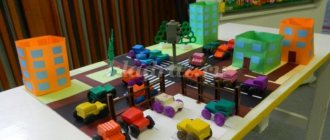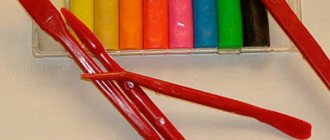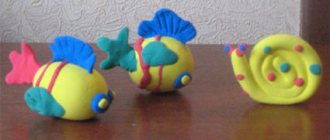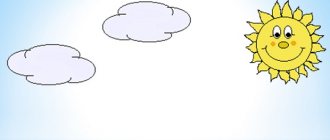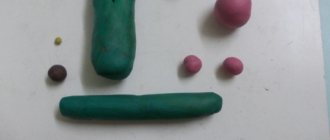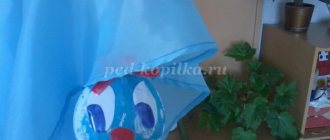Lesson summary for sculpting in 2 ml gr "Sunny"
Lesson in the second junior group on modeling on the topic: “Sun”
Goals:
- To form interest and a positive attitude towards the game, the desire to participate in the general action, to help fairy-tale characters;
- Encourage children to actively communicate and develop speech;
- Consolidate knowledge about the sun (what is it for? what is it like?);
- To teach how to convey the image of the sun, improving children’s ability to roll a piece of plasticine between their palms, giving it a spherical shape; teach the technique of flattening a ball on a horizontal surface to obtain a flat image of the original shape;
- Practice rolling lumps of plasticine between your palms with direct movements of both hands;
- To encourage in children the desire to finish what they start.
Material:
- scenery of a fairy forest, mountains, sun, clouds;
- forest animals: Bunny and Squirrel (roles played by children from the preparatory group);
- record player;
- thick blue cardboard, size - A4;
- yellow and red plasticine;
- hand wipe;
- modeling board.
Preliminary work:
- Walking around the kindergarten area in order to observe the sun (during walks, the teacher teaches children to peer into phenomena, compare them, see what is common and distinctive, and with questions encourages them to find their own words and expressions to describe what they see);
- Reading the fairy tale “Visiting the Sun”;
- Examining the sun in the picture, clarifying the shape and color of the sun;
- Drawing the sun;
- Learning songs and nursery rhymes about the sun;
- Guessing riddles about natural phenomena.
Progress of the lesson
1. Organizational part.
Cheerful music sounds to the tune of the Russian folk song “Shine, shine, sun.” Children sit in a semicircle on chairs, the teacher is in front of them. Behind the teacher there is a scenery of a forest, on the right side of the teacher there is a scenery of a large mountain and clouds.
The music gradually fades away.
Educator
: Guys, listen to a very interesting riddle and tell me what it says:
It warms the whole world and does not know fatigue. He smiles at the window, And everyone calls him...
Children
: Sun.
Educator
: That's right, it's the sun. It wakes up before everyone else, washes itself from the cloud and rises high into the sky to do “good deeds.” And what “good deeds” does the sun do?
Children
: It illuminates the earth and warms everyone.
Educator
: Yes, guys, that’s right, the sun has many “good deeds”: warming the earth, illuminating it with bright light, and waking everyone up with its gentle rays. But sometimes, guys, it happens that the sun does not come out into the sky and does not give us its warmth. Why do you think?
Children
: The clouds are hiding the sun, the sun is sick...
(Several answers from the children).
At that time, Bunny and Squirrel appear from behind the forest. Sad music plays, which gradually fades away.
Bunny and Squirrel
(together)
: Hello, guys.
Children
: Hello.
Bunny
: Squirrel and I came to you for help. For several days now there has been no sun in our fairy tale, and without the sun we are cold, lonely and sad. Guys, help us find the sun.
Educator
: Well, guys, let's help our fairy tale animals find the sun?
Children
: We'll help.
Educator
: Then we need to go with you to a fairy tale. But before we go, let's remember where we can look for the sun? Where does it live?
Children
: Behind the forest there is a big mountain, on a big mountain among the clouds the sun lives,
(Several answers from children).
Educator
: Well, then let's go!
Cheerful music is playing, children and animals are walking through a fairy-tale forest.
Physical education minute
Behind the sun, behind the sun (Walking in place, raising your knees high).
Along the meadow path Let us all go joyfully in the summer time.
The ringing birds are chirping, (Walking, arms up.)
Moths are fluttering,
(Walking with arms flapping up and down).
Dandelions are turning yellow,
(Walk with your body turning to the right, right hand to the side, left hand behind your back and repeat vice versa.
) Cornflowers are turning blue.
Children with animals approach a large mountain with many clouds at the top.
Children and animals (together):
(Russian folk song)
Bucket sunshine! Look out the window! Your children are crying, jumping on the pebbles! The springs are in place.
Sunny, dress up!
Red, show yourself! Jumping in place.
Children and animals call for the sun, but it does not appear.
Educator
: Guys, the sun doesn’t appear, apparently he’s not feeling well. Let's draw him while the sun is sick. Maybe then it will disperse the clouds and begin to give everyone its warmth.
The children go to the tables, the animals remain near the mountain.
Educator
: And we will draw the sun not with pencils or paints, but with the help of plasticine. To make the sun look like a real one, let's remember what it is like. What does it look like?
Children
: On a ball, on a button, on a ball.
Educator
: What color is the sun?
Children
: Yellow, red.
Educator
: That's right, guys.
2. Practical part.
Educator
:
1. You need to take red or yellow plasticine of your choice, divide it in a stack into two parts along the intended line. Place one part between your palms. Roll the ball in a circular motion from left to right (right to left), pressing on it with your palm.
2. Place the finished ball in the middle of the cardboard and lightly press on it, flatten it so that the sun ball is fixed on the cardboard.
3. Pinch off a small piece from the second part, place it between your palms and roll the sausage with straight movements of both hands. Attach the resulting ray-column to the sun and point it to the side, lightly pressing it against the picture along the entire length of the ray. Make the remaining rays in the same way.
Warm up your arms while working
Look: the sun is above us, (Draw
a semicircle with your hand above your head (swinging motion)).
Above the trees,
(Hands raised up, fingers open).
Houses,
(Hands folded over head like a house).
And over the sea, over the wave,
(Draw a wave with your hand).
And a little bit above me.
(Touch your head).
The children finish their work, at this time the sun appears from behind the clouds. The animals jump for joy. Cheerful music is playing.
Educator
: Guys, the sun, having dispersed the clouds, floated into the sky. We managed to help the animals.
The teacher draws the children’s attention to the sun that has appeared. The children are happy. Bunny and Squirrel thank the children for their help.
3. Final part.
Educator
: Today we had a very interesting lesson. Let's remember what we did in class?
Children
: We guessed a riddle, went with Squirrel and Bunny to the sun, called the sun, sculpted a sun, (Several answers from the children).
Educator
: What did you like most?
Children
: When the sun appeared, when the sun was sculpted.
Educator
: Guys, let's enjoy the sun and play a game.
Outdoor game “Sun and Cloud”
To the music of the teacher’s words “The sun is shining,” children run, frolic, and play; on the word “cloud” - the children sit on their chairs.
Educator
: Our lesson is over, you can rest.
Summary of educational activities for sculpting children of the second junior group “Plates for dolls”
Summary of direct educational activities
for sculpting children of the second younger group
"Plates for dolls"
Target:
creating an image of a decorative plate, mastering the technique of decorating a product with a rhythmic pattern, highlighting the edge and middle.
Tasks of the teacher:
1. Introduce decorative arts.
2. Develop the ability to roll the dough into a ball and flatten it into a disk with your palms.
3. Develop the ability to apply a rhythmic pattern along the edge and middle of a rounded flat shape.
4. To promote independence in the arrangement of decorative elements and in the choice of tools for applying the pattern.
Integration of educational areas:
“Speech development”, “Cognitive development”, “Artistic and aesthetic development”, “Physical development”, “Social and communicative development”.
Types of children's activities:
fine art - modeling from salt dough; motor - physical education;
game - game situation “Let's set the table for tea”; communicative - questions, answers, teacher’s story; musical - listening; perception of fiction and folklore - listening to a poem;
self-service and basic household work - cleaning the workplace
Methods and techniques.
Visual: method of aesthetic persuasion (looking at decorative plates, viewing a presentation), examination method.
Verbal: dialogue, reading an excerpt from a poem by E. Evseeva.
Practical: creating game motivation, the method of physical activity (physical education), the method of search situations, playing with an unfinished and completed image, one’s own emotional attitude.
Resources:
decorative plates for viewing, crafts made from salt dough (fruits, bagels, cookies), slides or illustrations with examples of decorating rooms with decorative plates, ready-made colored salt dough, stacks, sticks, cocktail tubes, oilcloths, wet wipes, foil, baking sheet.
Preliminary work
: games with Dymkovo and Filimonov folk toys (originals); design of an exhibition of folk toys; examination of illustrations depicting Dymkovo and Filimonov folk toys; making cookies from salt dough using molds and decorating them with stacks.
Contents of organized educational activities for children.
1. Game motivation.
The teacher brings decorative painted plates to the group (the pattern on the plates is located along the edge and in the middle). Children, if desired, come up and examine them. The teacher reads an excerpt from a poem by E. Evseeva: Plate - ah! Plate - wow! Made from fine porcelain. Whiter than the whitest fluff, And brighter than a traffic light.
Christmas ball. Summary of joint activities in the second junior group (modeling)
Summary of joint activities in the second junior group
Artistic creativity (modeling)
Date
: December 25, 2015
Topic
: New Year's miracle
Purpose:
Creating a social situation of development in the process of creative activity “Christmas Ball”
Objectives:
1. Create conditions for the development in children of the ability to sculpt familiar objects, using previously learned techniques: rolling out a ball, sausage, stretching plasticine.
2. Contribute to the formation of an idea about the New Year holiday and its attributes (Christmas tree decorations). 3. Systematize children’s knowledge about seasonal changes in nature. 4. Create conditions for choosing ways to decorate the Christmas ball. Organization of children's activities:
1. communication of the child with adults 2. communication of the child with peers.
Demonstration material:
image of a New Year tree decorated with Christmas tree decorations.
Handout:
template of a ball with a thread threaded through it and a loop, plasticine.
Progress of joint activities Stage of educational activities
Organization of work space
Adult activity
Children's activities
Psychological and pedagogical conditions/tasks
Introductory part (organizational and motivational point
)
There was a knock on the door, the postman brought a letter from the forest inhabitants.
The teacher offers to see who knocked on the door. Walking out the door, he returns with a letter. Offers to read the letter: “Hello, dear guys! The forest dwellers are writing to you: a bear cub, a little fox, and a little hare.” Thank you for your help, for your Christmas trees. Thanks to you, we now know what Christmas tree decorations are for. We decorated Christmas trees with them. But there are a lot of Christmas trees in our forest and we didn’t have enough Christmas tree decorations. Help us, please, make us more Christmas tree decorations so that we can decorate all the trees in the forest.” The teacher invites the children to help the forest inhabitants. Invites children to decorate Christmas tree balls.
Listen to the contents of the letter.
Inclusion in a game situation. Motivation to help forest dwellers.
Main part
Tables on which blanks for decoration, plasticine, stacks, modeling boards, napkins,
The teacher invites the children to help the forest inhabitants. He invites the children to decorate the Christmas tree balls that he has. -Guys, let's help the forest dwellers decorate the Christmas trees? — I already have Christmas balls (blanks), but they are not decorated. Want to decorate them? How can we decorate them? The teacher leads the children to the fact that they can decorate the balls with plasticine. The teacher offers to go to the tables and choose a Christmas tree toy that will be decorated. Shows children an example of how to decorate. During the activity, the teacher asks the children individual questions: what they are doing, what color of plasticine, for whom they are making toys, etc.).
Children's answers Make assumptions.
They go to the tables and start modeling. Answer questions.
Conditions for speech activity and children expressing their thoughts Conditions for creative activity. Conditions for speech and cognitive activity.
Reflection
Parcel for Christmas tree decorations.
The teacher invites the children to look at the toys they have made and express their opinions: - Guys, did you like decorating the Christmas tree toys? Which toy (Child’s name) do you like best, and why? What do you think, will the inhabitants of the forest like your toys? The teacher offers to put all the toys in a parcel and send it to the forest.
They express their opinions and answer questions.
Conditions for speech activity
